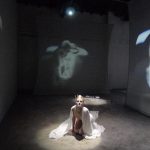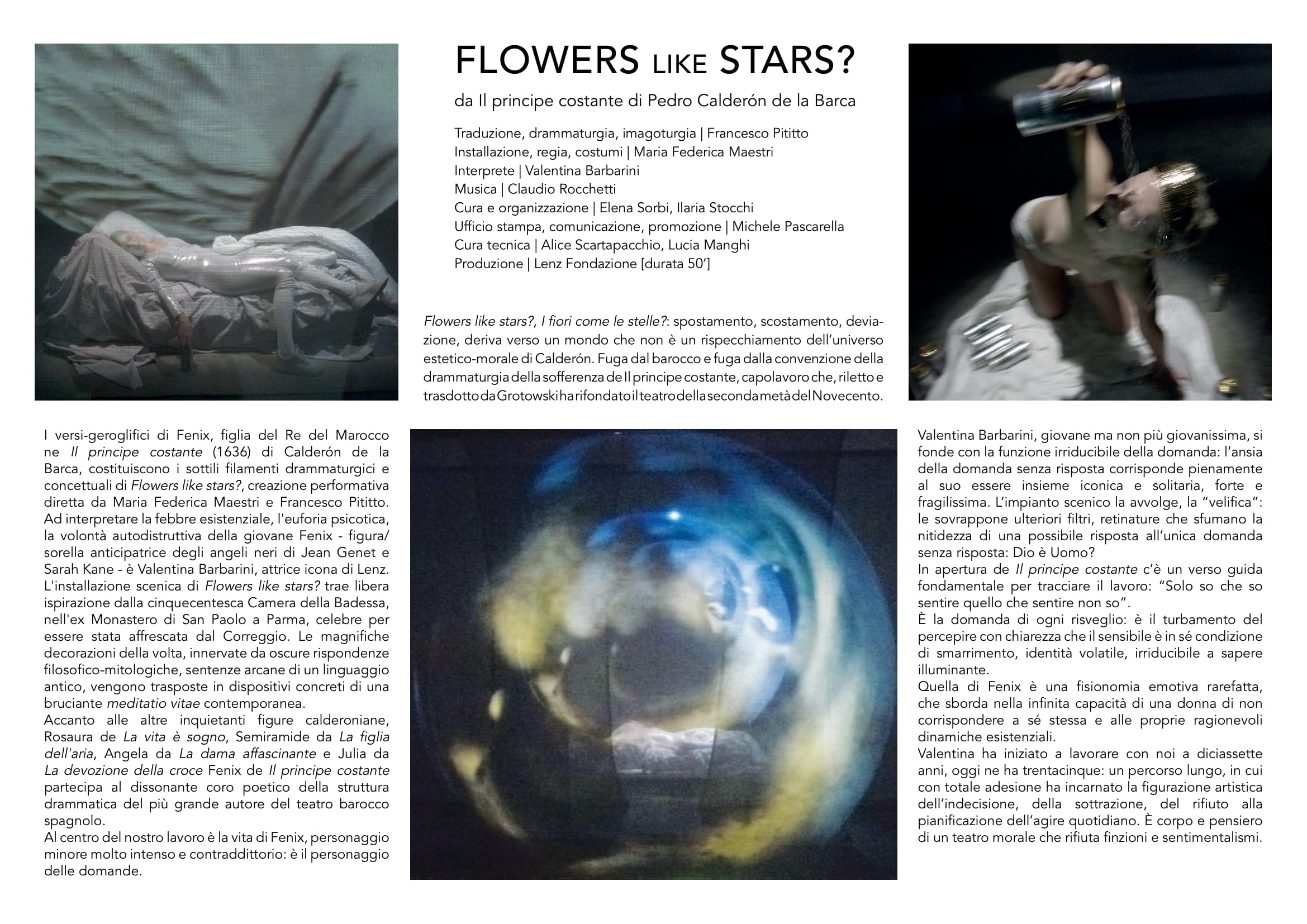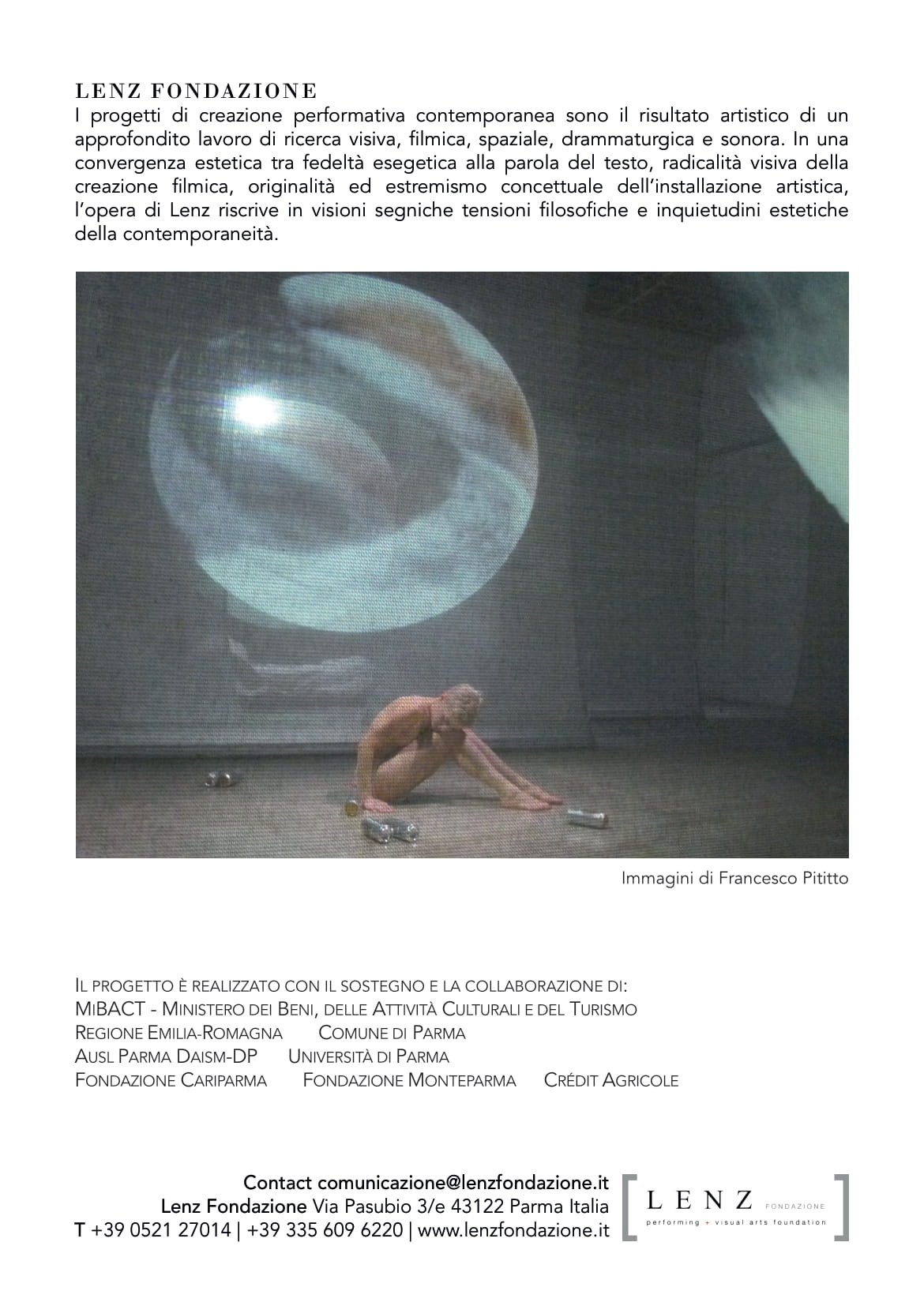
FLOWERS LIKE STARS?
The verse-geroglyphs of Fenix, daughter of the King of Morocco in The constant prince (1636) by Calderón de la Barca, constitute the subtle dramaturgical and conceptual filaments of Flowers like stars?, the new performance creation directed by Maria Federica Maestri and Francesco Pititto. To interpret the existential fever, the psychotic euphoria, the self-destructive will of the young Fenix – anticipatory figure/sister of the black angels of Jean Genet and Sarah Kane – is Valentina Barbarini, Lenz’s iconic actress.
The scenic installation of Flowers like stars? draws free inspiration from the 16th century Camera della Badessa, in the former Monastery of San Paolo in Parma, famous for having been frescoed by Correggio. The magnificent decorations of the vault, innervated by obscure philosophical-mythological answers, arcane sentences of an ancient language, are transposed into concrete devices of a burning contemporary meditatio vitae.
Alongside the other disturbing Calderonian figures, Rosaura from Life is Dream, Semiramide from The daughter of air, Angela from The charming lady and Julia from The devotion of the cross, Fenix from The constant prince participates in the dissonant poetic chorus of the dramatic structure of the greatest author of Spanish Baroque theatre.
Valentina Barbarini, interpreter since 2005 of Lenz’s most important creations, has already shown herself as a fragmented and fragile feminine power in the guise of Fenix in The constant prince by Calderón de la Barca, in an installation created between Italy, Spain and Morocco in 2006. In Radical Change – a project on Ovid’s Metamorphoses (2007) – she interpreted a further refraction of the Phoenix, the sacred bird that when it reaches the age of five hundred years lays its limbs in a nest, then dies. From the ashes of its body another little Phoenix will be born in an eternal life-death cycle. Flowers like stars? represents one of these infinite rebirths, in a place monumental in beauty and history, just as immortal.
What is beauty for / if I lack joy / if I’m out of luck?
–
What today is melancholy / maybe it’s just my sadness
only I know that I feel / what feeling I know not
that this is an illusion of the soul.
Flowers like stars?: displacement, deviation, drift towards a world that is not a reflection of the aesthetic-moral universe of Calderón. Escape from the baroque and escape from the convention of the dramaturgy of suffering of The constant prince, a masterpiece that, re-read and transcribed by Grotowski, has refounded the theater of the second half of the twentieth century.
At the centre of our work is the life of Fenix, a very intense and contradictory minor character: she is the character of questions.
Valentina Barbarini, young but no longer very young, merges with the irreducible function of asking: the anxiety of the unanswered question fully corresponds to her being both iconic and solitary, strong and very fragile. The scenic system envelops her, “velifies” her: it superimposes further filters on her, screens that blur the clarity of a possible answer to the only unanswered question: Is God Man?
In the opening of The constant prince there is a fundamental guiding verse to trace the work: “Only I know that I can feel what I feel I don’t know”. It is the question of every awakening: it is the disturbance of perceiving with clarity that the sensitive is in itself a condition of bewilderment, a volatile identity, irreducible to enlightening knowledge. Fenix’s is a rarefied emotional physiognomy, which overflows in the infinite capacity of a woman not to correspond to herself and to her own reasonable existential dynamics. Valentina started working with us when she was seventeen, today she is thirty-five: a long path, in which she has totally adhered to the artistic figuration of indecision, subtraction, refusal to plan everyday actions. She is the body and thought of a moral theatre that rejects fiction and sentimentality.
Valentina Barbarini has been the interpreter of many important productions of Lenz: The Little Mermaid, The constant prince, High surveillance, The mark of a god, Daphne_you must be my tree, Radical change_Phoenix, Chaos, Give us, child, your eyes, Poliantea, Exilium, Exilium_The great scar, Die Schachtel, Aeneis, Aeneis in Italy, The Isle of Dogs_Burning, The glory, The Betrothed, Verdi King Lear, Hyperion, The Furious, Romeo and Juliet_concert, Autodafé, Paradise, Purgatory, Verdi Macbeth, Iphigenia in Aulis, The great theatre of the world, Oresteia.
FLOWERS LIKE STARS?
from The constant prince by Pedro Calderón de la Barca
Translation, dramaturgy, imagoturgy | Francesco Pititto
Installation, direction, costumes | Maria Federica Maestri
Interpreter | Valentina Barbarini
Music | Claudio Rocchetti
Care and organization | Elena Sorbi, Ilaria Stocchi
Press office, communication, promotion | Michele Pascarella
Technical care | Alice Scartapacchio
Technical assistant | Marco Cavellini
Video media | Doruntina Film
Production | Lenz Foundation
Duration | 50 minutes
teaser:
trailer:
full video:
The muscular and androgynous body of Valentina Barbarini moves in a scenic installation freely inspired by the Camera della Badessa frescoed by Correggio in the former Monastery of San Paolo in Parma, whose cryptic philosophical-mythological correspondences are translated into ephemeral images and projected boneless words on screens of veil [more].
Emanuela Zanon, Juliet Art Magazine
The performative construction is radical but, while constantly showing the tension to risk, the body is never reduced to mechanics – as often happens in sterile compositions passed off as contemporary art – and inhabiting the scene is never a passive envelope, despite the ecology. stage forces him to continuous genuflections from which stoically it will be more and more complex to get up [more].
Daniele Rizzo, Persinsala


















